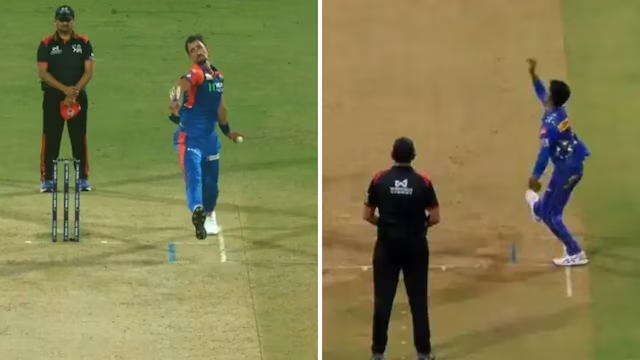Explained: Why Vignesh Puthur Wasn’t Punished for Bowling Like Mitchell Starc’s Back-Foot No-Balls?

The IPL 2025 clash between Delhi Capitals (DC) and Rajasthan Royals (RR) at the Arun Jaitley Stadium in Delhi turned out to be an edge-of-the-seat thriller, ultimately decided by a Super Over. While Mitchell Starc emerged as the hero for DC with his sensational bowling at the death, controversy wasn’t far behind.
On the fourth ball of the Super Over, Starc was penalized for a back-foot no-ball, where his back foot was deemed to have landed outside the return crease. The third umpire signaled the no-ball instantly, sparking debate on social media.
Soon after, several fans pointed out what seemed like similar back-foot violations by Mumbai Indians’ spinner Vignesh Puthur earlier in the season. Strangely, Puthur hadn’t been called for a no-ball in those instances. So, was there a double standard? Let’s break it down.
What Does the Law Say?
The MCC Laws of Cricket, which IPL follows, state the following under Law 21.5 – Fair Delivery: The Feet:
- 21.5.1: The bowler’s back foot must land within and not touching the return crease.
- 21.5.2: The front foot must land with some part behind the popping crease and on the correct side of the pitch.
If any part of the back foot touches or lands outside the return crease, it’s ruled a no-ball.
What Did Vignesh Puthur Do Differently?
Upon video review of the earlier matches, where Vignesh Puthur was under the spotlight:
- The MI spinner landed his back foot on his toes, inside the return crease.
- His heel then followed through and crossed over — but crucially after the foot had legally landed.
- This toe-first action meant that at the point of landing, Puthur was within the legal boundary.
Hence, his delivery was technically legal under Law 21.5.1, despite appearing marginally close when seen in real-time.
Starc vs Puthur: The Difference
- Mitchell Starc’s back foot landed outside the return crease, triggering a no-ball immediately.
- Puthur’s foot landed inside the crease and then moved out – which is allowed as per the law.
This key difference — landing vs follow-through — is the reason Starc was penalized and Puthur wasn’t.
Fan Reaction
The comparison led to heated discussions online, with some claiming inconsistency in umpiring decisions. However, the law is clear, and in this case, both calls were correct upon closer scrutiny with slow-motion replays and freeze frames.
Conclusion
While on the surface both incidents seemed similar, the timing and position of the back foot landing made all the difference. The umpires followed the letter of the law in each case.
In the high-speed world of T20 cricket, especially in tournaments like IPL where every ball can change a match, such technicalities often become the subject of massive debates. But the third umpire’s job is clear-cut—apply the rules as they are written.
So, Vignesh Puthur remains in the clear, and Mitchell Starc’s no-ball was rightly called, ensuring a fair outcome in both situations.



